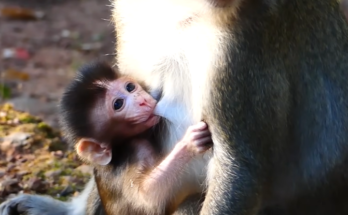I still remember the heavy air that morning—damp with jungle mist, the scent of ancient stones and wild growth all around. I’d walked deep into the forested corridors surrounding Angkor Wat, camera in hand, intent on capturing the hidden lives of the macaques that make their home here. I went quietly, hoping only to observe—not intervene.
At first, everything seemed normal: a troop of long-tailed macaques moving among the roots of trees, the slow sunrise light filtering through the canopy, birds calling. Then I spotted her: a mother monkey, a delicate brown-furred face, cradling a newborn tightly to her chest. The baby was tiny, its eyes scarcely open, its limbs trembling with the cold of the forest floor. I felt my heart catch: life in its purest vulnerable form.

I crouched behind a moss-covered ruin, watching. The mother’s eyes were alert, her body tense. She shifted, and then something changed. A flash of recognition in her eyes—fear? doubt?—and she slowly placed the baby on the ground, between mossy roots and twisted vines. I froze. I expected her to pick it back up, to shuffle closer, wrap an arm around it. But she didn’t.
Instead, she took a few steps away. I watched in horror: the baby whimpered, its tiny body flat against the damp earth, limbs splayed. The mother looked back once, then again, and turned away completely, vanishing into the undergrowth among ancient stones of the temple ruins.
I dashed forward—in my mind wanting to stop time—but I did not want to interfere. I knew the rules: wild animals must live wild. But inside, I felt a crack. The baby, alone, made a small noise. I heard it, felt it. The forest itself seemed to hold its breath.
For what felt like eternity the baby lay still, tiny chest rising and falling. I noted the dampness of the leaf litter, the green glow of the moss on the stone beside it, the way a single ray of sun caught its fur. I felt tears come unbidden. The surrounding jungle seemed vast, uncaring, yet I stood there feeling an intense responsibility just by being witness.
Then the troop’s alarm call sounded—a sharp, distant shriek—and the mother’s voice echoed in the rustle of branches. But she did not return to the baby. Instead she rejoined the group, moving away. The baby remained. I watched as its eyes slowly opened, scanned the gloom. It made a tiny attempt to sit up, wobbling. I ached inside.
I looked at the ancient temple walls behind it—carved stories of gods and kings, silent watchers of centuries—now witness to this quiet tragedy. It struck me how fragile life is, even in a place that has seen epochs pass.
My mind raced: Why did she do it? Was the baby ill? Was the troop under stress? In wildlife behaviour I know there are harsh realities—sometimes a mother abandons a sick newborn. But none of that made the moment any less heartbreaking.
I stayed until the baby tried to call out again—a soft squeak—the forest swallowing it. I gingerly removed my camera, capturing the image, knowing this moment must be shared, must speak to others. I left the forest slowly, my heart heavy, ears still tuned to the faintest sound of the baby behind me.
Back in civilization I kept seeing the image of that little body on the ground—so exposed, so alone. I thought of American readers, far away, thinking of cute baby monkeys in trees, but this was real life: wild, raw, unfiltered. I felt compelled to share it with you, because sometimes what we must face is the uncomfortable truth: nature can be merciless, and life can begin with heartbreak.
I hope this story gives you more than a glance—it gives you a moment of empathy. That baby monkey is not just a wild animal in a remote jungle. It is living, breathing, fearing, hoping. And its story deserves to be told.


